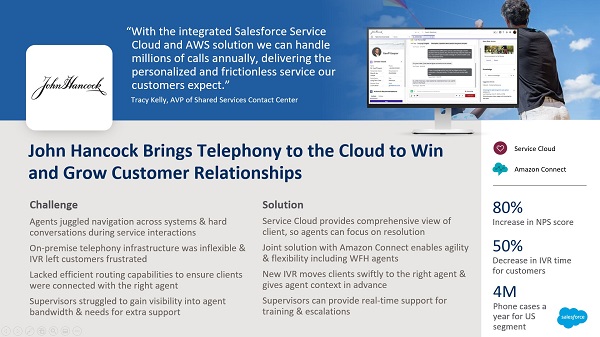Last week I was privileged to participate in a Salesforce-sponsored webinar, hosted by Enterprise Connect and No Jitter, on “
Optimizing the Agent Experience from Anywhere,” along with Tracy Kelly, assistant vice president of John Hancock’s Shared Services Contact Center, and Patrick Beyries, vice president, product management, Salesforce Service Cloud. The highlight of the event was an interview with Kelly, who shared why and how the John Hancock contact centers she leads moved from premises-based to cloud solutions. The conversation bridged to how that move impacted the contact center's ability to operate during the pandemic.
Here I share a summary of Kelly's responses to some of my questions.
What decisions had you made for John Hancock’s Shared Services operation prior to COVID-19 that helped ensure the contact centers were successful in the face of the shelter-in-place challenges?
John Hancock Shared Services began a contact center transformation in 2018, which it completed this January, Kelly explained. The technology change involved moving telephony from an on-premises system to a cloud solution, AWS’s Amazon Connect, and then integrating with Salesforce (read my earlier posts on the Salesforce-Amazon Connect integration
here and
here).
“We had also expanded our work-from-home (WFH) agents over the course of the last couple of years,” Kelly said. Working with the
Military Spouse Employment Partnership and the
National Telecommuting Institute, Shared Services already had about 65% of its customer service representatives working from home full-time. Fortunately, every manager in the contact center had at least a few WFH agents, she said. As a result, they were already familiar with managing employees in a remote setting.
The combination of a large proportion of agents working from home, on a cloud-based solution, “made the transition pretty smooth once the shelter-in-place order came down, Kelly said. “We did not lose any productivity. In fact, we've actually improved our productivity.”
In addition to providing flexibility in supporting WFH agents, why did John Hancock Shared Services decide to migrate from a premises-based contact center to the cloud?
The on-premises contact center and IVR technology were four or five years old, “and just weren't meeting customer or our internal expectations any longer,” Kelly shared. Another John Hancock contact center had already started using Salesforce Service Cloud. After meeting with AWS and Salesforce, Kelly and her team decided on the cloud-based solutions to "create a lot more flexibility with how we service our customers.”
As Kelly reported, and is shown on the graphic above, John Hancock “has absolutely seen a significant increase in Net Promoter Score (NPS) since implementing these solutions. The team has had “great scores on employee engagement surveys” since making the technology change, she added.
How does John Hancock Shared Services prioritize the agent experiences, and how do you think agent experience translates into customer experience?
While it is difficult to remember now, companies were facing a tight labor market before the pandemic hit, Kelly said. As a result, it became even more critical that John Hancock’s Shared Services contact centers were able to “provide state-of-the-art tools to our agents.” Kelly said she understood that such tools would make the job a little bit easier because “it's certainly not easy talking to 50 or 60 people a day.”
In terms of impact on the customer experience, Kelly explained that agents were part of the technology transformation team. The company continues to ask agents for feedback about what else can be done to make the experience of talking to customers easy so that agents "are not distracted and can really focus on what the customer needs," she said.
Along the lines of making the agent task easier, since the pandemic, John Hancock has implemented the capability to store call transcripts in the Salesforce call record. This has led to increased productivity because agents "don't have to spend as much time writing call summaries as they did in the past,” Kelly said. The audio file also becomes part of the Salesforce call record.
Kelly shared more thought-provoking insights during the webinar, during which Salesforce’s Beyries gave an update on Salesforce's release of Service Cloud Voice for Amazon Connect. Be sure to
listen to the entire webinar on demand!










